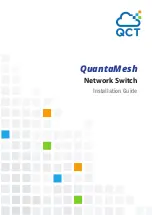
3-7
Connecting Switches in a Stack
3
Connecting Switches in a Stack
Figure 3-7 shows how the stack cables are connected between switches in a stack.
Each stacking connection is a 48 Gbps full-duplex high-speed serial link using
proprietary stacking cables. The switch supports a line- and ring-topology stacking
configuration, or can be used stand alone. To ensure minimal disruption in case a
unit or stacking cable fails, we recommend always use a ring-topology.
In line-topology stacking there is a single stack cable connection between each
switch that carries two-way communications across the stack. In ring-topology
stacking, an extra cable is connected between the top and bottom switches forming
a “ring” or “closed-loop.” The closed-loop cable provides a redundant path for the
stack link, so if one link fails, stack communications can still be maintained. Figure
3-7 illustrates a ring-topology stacking configuration.
To connect up to eight switches in a stack, perform the following steps:
1.
Plug one end of the stack cable (ordered separately) in the Down (right) port of
the top unit.
2.
Plug the other end of the stack cable into the Up (left) port of the next unit.
3.
Repeat steps 1 and 2 for each unit in the stack. Form a simple chain starting at
the Down port on the top unit and ending at the Up port on the bottom unit
(stacking up to 8 units).
4.
(Optional) To form a wrap-around topology, plug one end of a stack cable into
the Down port on the bottom unit and the other end into the Up port on the top
unit.
Figure 3-7 Making Stacking Connections
Summary of Contents for 8926EM
Page 18: ...xiv Figures ...
Page 26: ...Introduction 1 8 1 ...
Page 34: ...2 8 Network Planning 2 ...
Page 44: ...3 10 Installing the Switch 3 ...
Page 56: ...A 4 Troubleshooting A ...
Page 62: ...B 6 Cables B ...
Page 73: ...Index Index 3 V VLANs routing 2 6 tagging 2 5 W web based management 1 2 ...
Page 74: ...Index Index 4 ...
Page 75: ......
















































